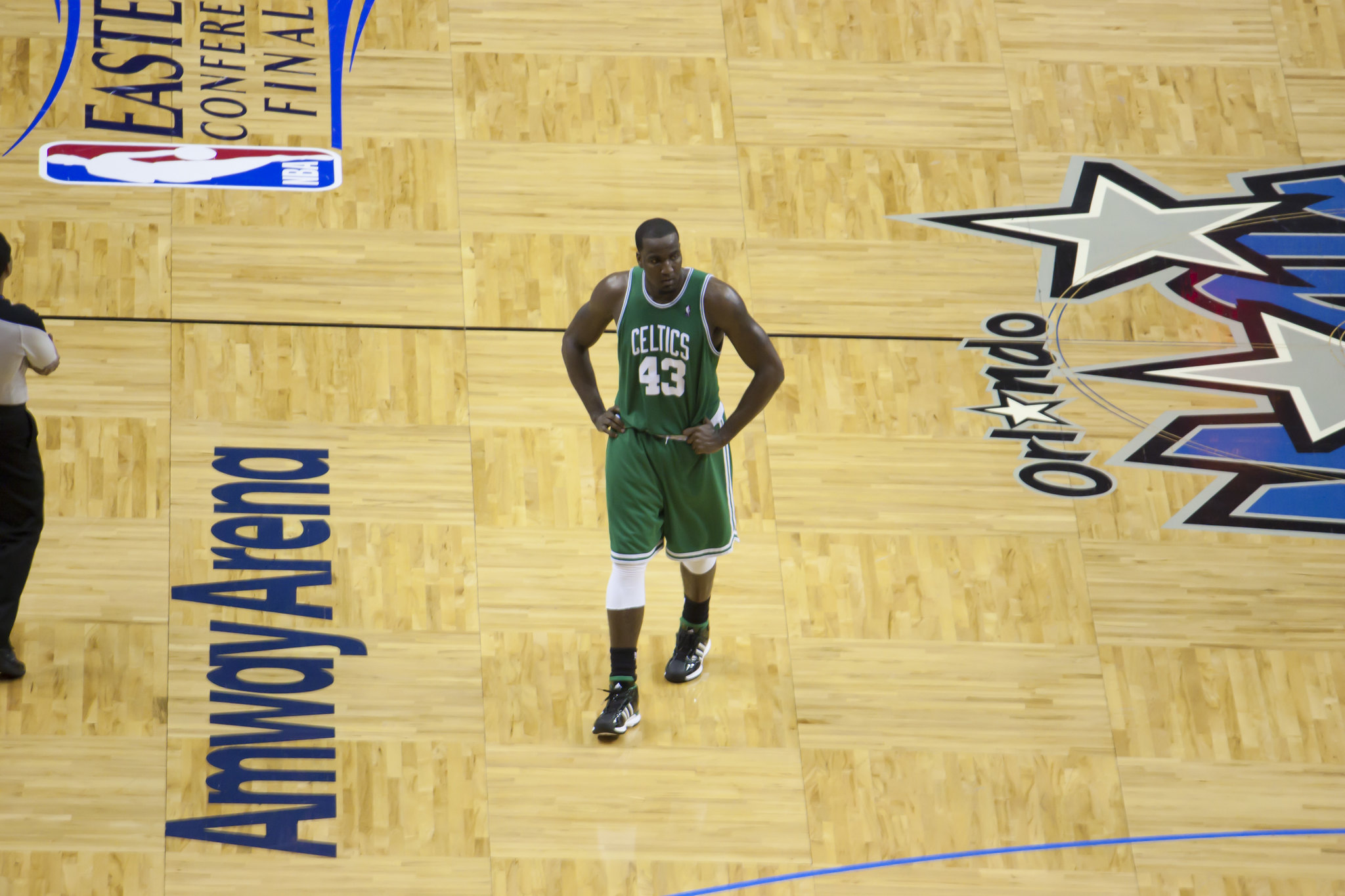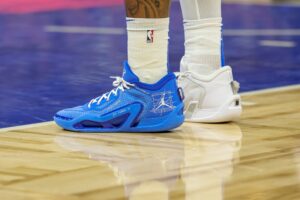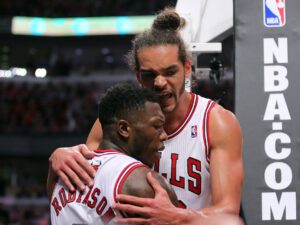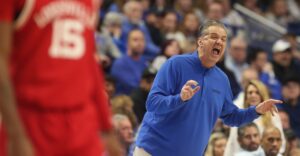In 2011, the Boston Celtics dealt fan favorites Kendrick Perkins and Nate Robinson to the Oklahoma City Thunder for Jeff Green and Nenad Krstic at the 2011 trade deadline.
Over a decade later, there is still a debate about whether this trade ever should have happened and who came away with the better deal.
Let’s dive in a little bit deeper to determine who the winner of this Kendrick Perkins-Jeff Green trade was. And, if it even made sense for either team to do.
Celtics Trade Throwback #1: Kendrick Perkins to The Thunder
Full Trade Details
Boston Celtics trade: Kendrick Perkins and Nate Robinson
Oklahoma City Thunder trade: Jeff Green, Nenad Krstic, cash, 2012 first-round pick (later became Fab Melo), and a 2013 second-round pick (given by NBA due to Green’s medical condition causing him to miss the entire 2011-12 season–pick later became Alex Abrines).
State of the Boston Celtics Before the Trade
First things first, context is essential here.
Just one season prior, the Celtics lost to the Los Angeles Lakers in seven games in the NBA Finals.
One of the reasons many believe the Celtics lost despite having a 3-2 series lead was because of Perkins’ injury. At the time, Perkins was the defensive anchor alongside Kevin Garnett. Losing him during Game 6 and not having him for Game 7 (both games the Celtics lost) changed the outcome of the series.
The Celtics’ “Big Three” of Garnett, Paul Pierce, and Ray Allen was still in tact. Because of this, it made sense for the Celtics to run it back with the same core.
And up until the 2011 trade deadline, it seemed to work.
At the time of the trade, the Celtics were 41-15 and sat atop the Eastern Conference standings.
Yes, even over the Miami Heat with a shiny new “Big Three” of their own (comprised of LeBron James, Dwyane Wade, and Chris Bosh) and the Chicago Bulls who were led by Derrick Rose, the eventual MVP of this season.
The reigning Eastern Conference champions looked poised to make it to their third NBA Finals in four years. Plus, with Perkins having just returned from his injury, the sky was looking like the limit for the Celtics.
State of the Oklahoma City Thunder Before the Trade
As for the Thunder, they were 36-20 and in fourth place in the Western Conference standings.
Just one year prior, the Thunder were eliminated in six games in the first round by the eventual champion, the Lakers. The Thunder had reason to be optimistic for the future despite getting knocked out so early. Their young star Kevin Durant was the scoring champion of the 2009-10 season, and they were the youngest NBA team in history to make the playoffs.
With a young core that also included Russell Westbrook, James Harden, and Serge Ibaka, the Thunder needed one last piece to build a contender.
With Jeff Green being a free agent at the end of the season, moving on from him at the trade deadline made sense for the Thunder.
Why the Celtics Made the Trade
Perkins’ contract expired at the end of the 2010-11 season. The Celtics did offer him a $22 million extension before shipping him out, but the big man rejected the offer. Due to their lack of salary cap, the extension the Celtics offered was their maximum.
It also made sense for the Celtics not to clear cap space and gamble on Perkins, who had just made his way back from the knee injury that knocked him out of the Finals the year before.
There was a sense of urgency to get something in return for Kendrick Perkins through a trade when it looked like he wasn’t a long-term option for the Celtics. Pair this with the team betting on both Shaquille and Jermaine O’Neal being healthy and impactful for the team that year (they weren’t), there was a good reason to move Perkins and address other needs.
The Celtics were an older team at this point and their “Big Three” had evidently seen better days.
To combat this, the team wanted to go younger and acquire some additional wing scoring. That’s where the idea of trading for Green was appealing to the Celtics.
Green was drafted by Boston with the fifth pick in the 2007 NBA Draft. The team then dealt him to the Seattle Supersonics for Allen. Green was about to be 25 years old and was looking like a solid asset. He could contribute to the Celtics immediately but could also be the next franchise star once the “Big Three” departed.
As for the acquisition of Krstic and departure of Nate Robinson in the trade, it was likely more for salary cap purposes for the Celtics than anything. Although, Krstic did offer experience and size if the O’Neals weren’t able to stay on the court.
Why the Thunder Made the Trade
For the Thunder, this trade was more about solidifying their frontcourt than trading away Green. Krstic was a solid center, but he wasn’t as good as Perkins. The Thunder believed in the Perkins acquisition so much that they agreed to a four-year extension worth $34.8 million before he even suited up for the team. And on paper, it was hard to blame them for that.
The Thunder were looking to take their team to the next level. Plus, Perkins became the only player on that Thunder team with a ring besides Nazr Mohammed (who won with the San Antonio Spurs in 2005).
Perkins had championship experience and was going to be the defensive anchor on that team. This was much more valuable for the Thunder than having another wing scorer in Green, who was likely gone in free agency at season’s end.
Aftermath of the Trade
Over 12 years later, the aftermath of this trade is final. As you could probably imagine, none of the players involved are currently with the Celtics or Thunder respectively. In fact, only one of them is still playing in the NBA in 2023.
So, what happened between both teams and all the players involved after the trade went through?
Boston Celtics
After acquiring Jeff Green and Nenad Krstic in a trade with the Thunder, the Celtics ended the regular season with a 56-26 record, which was third-best in the Eastern Conference. Boston swept the New York Knicks in the first round of the playoffs before falling to the Heat in five games in the next round.
Shaquille O’Neal only appeared in two games in the postseason for Boston (both against Miami) and only recorded a total of two points with no rebounds or blocks. He retired during the offseason.
Jermaine O’Neal played and started for the Celtics in all nine of their postseason games but only averaged 21.9 MPG. He also averaged 5.8 PPG, 4.2 RPG and 1.8 BPG. Although this O’Neal was more impactful, the team was clearly missing a more dominant presence like Perkins in the postseason.
The Celtics nearly got their revenge the next season when they lost to the Heat in seven games in the Eastern Conference Finals. The following offseason, longtime Celtics star Ray Allen switched sides and joined the Heat.
During the playoffs in 2013, the Celtics were eliminated by the Knicks in six games. The following offseason saw the team trade away Pierce and Garnett to officially begin the post-“Big Three” era in Boston.
The Celtics wouldn’t make it to the NBA Finals again until 2022, when they lost to the Golden State Warriors in six games.
Nenad Krstic
Nenad Krstic played in 24 regular season games for the Celtics and started 20 of them after his trade from the Thunder.
In these games, Krstic averaged 9.1 PPG and 5.3 RPG on 53.7 FG% in 23 MPG. This includes a 20-point, 9-rebound performance in a 108-103 loss to the Los Angeles Clippers on March 9, 2011.
The Serbian big man didn’t see much playing time during the postseason and only appeared in seven games for the Celtics. Krstic averaged 1.7 PPG and 1.7 RPG in 8 MPG in those games.
Nenad Krstic was a solid big for the Celtics after his trade from the Thunder, but this relationship last long.
Not only was 2011 Krstic’s only year with the Celtics, it was also his last year in the NBA.
The following offseason, Krstic signed a two-year deal with CSKA Moscow to play overseas and never returned to the NBA.
Jeff Green
In 26 games (two starts) with the Celtics for the rest of the season after the trade, Green showed that he could be a solid bench contributor behind Pierce. Green averaged 9.8 PPG and 3.3 RPG on 48.5 FG% in 23.5 MPG.
The Georgetown alum had his Celtics breakout in a 95-94 overtime loss to the Washington Wizards on April 11, 2011. In this game, Green scored 20 points and secured 15 rebounds. He also dished four assists and recorded two steals in 47 minutes.
Green was solid in the postseason as he averaged 7.3 PPG and 2.7 RPG over 19.2 MPG.
After the 2011 lockout ended, Green re-signed with the Celtics on a one-year deal worth $9 million. It was shortly announced, however, that Green would undergo heart surgery in January and would miss the entire 2011-12 season. Green’s contract was voided for the season.
Green eventually returned and signed another contract with the Celtics.
In January 2015, Green was traded by Boston to the Memphis Grizzlies. This was a month after the team traded their franchise point guard Rajon Rondo to the Dallas Mavericks. Green looked like a star at times. Still, it became evident that the team was looking to move into a different direction.
In parts of four seasons with the Celtics, Green averaged 14.6 PPG, 4.2 RPG, and 1.5 APG on 43.8 FG%.
Green would become a journeyman for the rest of his career and bounced around the league before finally winning an NBA championship with the Denver Nuggets in 2023. In fact, at some points in his career, Green would reunite with Durant, Westbrook, and Harden as teammates on different teams.
In July 2023, Green signed a contract with the Houston Rockets for his second stint with the team.
Oklahoma City Thunder
The Thunder ended the season with a 55-27 record, fourth-best in the Western Conference. Led by their version of the “Big Three,” the Thunder defeated the Nuggets in five games in the first round. They would then go on to defeat the Grizzlies in seven games in the second round before losing to the eventual champion, the Mavericks, in five games in the Western Conference Finals.
One season later, the Thunder made it to the NBA Finals before losing to the Heat in five games. The Thunder have yet to make it back to the NBA Finals despite appearing in two Western Conference Finals since (2014 and 2016).
In 2012, the Thunder traded Harden away to the Rockets.
Also, infamously, Durant, the 2014 MVP, left the Thunder in 2016 and signed with the Warriors.
And in 2019, the Thunder traded 2017 MVP Westbrook to the Rockets. This trade officially ended this era of the franchise.
Kendrick Perkins
Kendrick Perkins played 17 games for the Thunder as the Nenad Krstic replacement following his trade from the Celtics. Perkins averaged 5.1 PPG and 7.9 RPG in those 17 games.
That postseason, Perkins averaged 4.5 PPG and 6.1 RPG. Perkins would play with the Thunder before getting traded to the Utah Jazz in 2015, where he was waived before ever suiting up for the team. At this point, Perkins’ role was completely diminished as he played backup to Steven Adams.
Perkins signed with the Cleveland Cavaliers after the Jazz released him. The big man started no games and rarely cracked the rotation.
In 2015, Perkins signed with the New Orleans Pelicans but, again, was more of a depth piece rather than a role player or starter.
Perkins would make his way back to Cleveland for one game in 2018. Funny enough, Green was also a member of this Cavaliers team and the two played together for one game.
The Warriors swept the Cavaliers in the Finals that year. Perkins didn’t log a single minute during the series. Perkins retired shortly after in 2019.
Nate Robinson
Nate Robinson only played in four games for the Thunder after his trade from the Celtics. He did appear in three postseason games for the Thunder, but he only averaged 4 MPG and was a non-factor. The Thunder cut him prior to the 2011-12 season.
For the 2011-12 season, Robinson made his way to the Warriors. Afterwards, Robinson bounced around the league and played for the Bulls, Nuggets, Clippers, and Pelicans.
Interestingly, Nate Robinson made his way back to the Celtics in 2015 in a trade for Jameer Nelson. The Celtics cut the three-time Slam Dunk Contest winner before he could suit up.
Nate Robinson was a serviceable rotational guard after his trade from the Celtics. The 5’9″ guard was out of the league in 2015, however.
Did This Trade Even Make Sense?
Although moving on from Perkins was understandable, the risk didn’t pay off for the Celtics.
The team missed his presence for the rest of the “Big Three” era. In fact, the Celtics didn’t have a definitive top-tier big man again until they signed Al Horford in 2016.
Green was a good player for the Celtics and probably had his best years in Boston. The 2007 lottery pick has made a career as a good bench piece for many teams since being traded by the Celtics. That said, he wasn’t the next face of the franchise many thought he would end up being in Boston.
However, Green’s absence during the 2011-12 season is a big “what if” in recent Celtics history.
That Celtics team was only one win away from the NBA Finals that year. It’s easy to imagine that Green would’ve been a big help to get them past the Heat. In hindsight, this could’ve been Green’s breakout campaign.
This would’ve been his first full year playing with the Celtics’ “Big Three” in a solidified role. A chance to play next to Pierce and Garnett could’ve been big for Green;s career.
As for the Thunder, Perkins proved to not be worth his big contract. He was decent with the team. Even so, he wasn’t the big game-changer he was expected to be in OKC.
The Thunder sending Jeff Green to the Celtics through trade wasn’t detrimental to the team. In fact, it made sense for them to trade him for Perkins, a good fit for the team on paper. That said, Green has had the best career of all the players involved in this trade since it happened.
Hindsight is 20/20. Even so, it’s fair to wonder if the Thunder could’ve gotten a better return for the 2023 champion.
Verdict
Neither team “won” or “lost” the trade, but to not take the easy route–the Celtics probably have the advantage.
The Celtics got a good wing from the Thunder in Jeff Green in the trade but lost a defensive anchor to make it happen. The Thunder traded away a homegrown player for someone who eventually became overpaid and a burden to the franchise.
Essentially, the Celtics got more out of Jeff Green and Nenad Krstic than the Thunder did out of Kendrick Perkins and Nate Robinson following the trade.
Still, it’s fair to say this trade shouldn’t have happened and the Celtics should’ve rode it out with Kendrick Perkins–even if Danny Ainge doesn’t agree.






